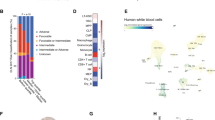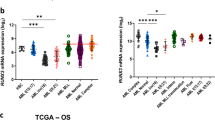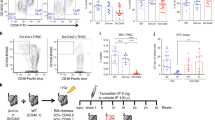Abstract
FHL2 is a multifunctional LIM domain protein that acts as a transcriptional modulator mediating proliferation and apoptosis in a tissue-specific manner. Upregulation of FHL2 has been detected in a variety of cancers. We demonstrate that upregulation of FHL2 is associated with a subset of acute myeloid leukemia with a characteristic gene-expression signature, and abnormalities of chromosome 5. In mice, expression of endogenous Fhl2 is downregulated coordinately during the differentiation of hematopoietic cells. Upregulation of FHL2 enhances proliferation of myeloid progenitor cells, and serial-replating efficiency of hematopoietic cells in vitro. Chimeric mice with enforced expression of FHL2 in bone marrow cells, are characterized by an expanded pool of myeloid progenitor cells, enhanced granulopoi esis and megakaryocytopoiesis. In addition, enhanced expression of FHL2 promotes cell-cycle entry of myeloid progenitor cells and increases the frequency of apoptosis of bone marrow cells in vivo. These results raise the possibility that deregulation of FHL2 contributes to the development of human myeloid disorders.
This is a preview of subscription content, access via your institution
Access options
Subscribe to this journal
Receive 12 print issues and online access
$259.00 per year
only $21.58 per issue
Buy this article
- Purchase on Springer Link
- Instant access to full article PDF
Prices may be subject to local taxes which are calculated during checkout





Similar content being viewed by others
Accession codes
References
Pedersen-Bjergaard J . Insights into leukemogenesis from therapy-related leukemia. N Engl J Med 2005; 352: 1591–1594.
Smith SM, Le Beau MM, Huo D, Karrison T, Sobecks RM, Anastasi J et al. Clinical-cytogenetic associations in 306 patients with therapy-related myelodysplasia and myeloid leukemia: the University of Chicago series. Blood 2003; 102: 43–52.
Qian Z, Fernald AA, Godley LA, Larson RA, Le Beau MM . Expression profiling of CD34+ hematopoietic stem/ progenitor cells reveals distinct subtypes of therapy-related acute myeloid leukemia. Proc Natl Acad Sci USA 2002; 99: 14925–14930.
Genini M, Schwalbe P, Scholl FA, Remppis A, Mattei MG, Schafer BW . Subtractive cloning and characterization of DRAL, a novel LIM-domain protein down-regulated in rhabdomyosarcoma. DNA Cell Biol 1997; 16: 433–442.
Bach I . The LIM domain: regulation by association. Mech Dev 2000; 91: 5–17.
Johannessen M, Moller S, Hansen T, Moens U, Van Ghelue M . The multifunctional roles of the four-and-a-half-LIM only protein FHL2. Cell Mol Life Sci 2006; 63: 268–284.
Chu PH, Bardwell WM, Gu Y, Ross Jr J, Chen J . FHL2 (SLIM3) is not essential for cardiac development and function. Mol Cell Biol 2000; 20: 7460–7462.
Kong Y, Shelton JM, Rothermel B, Li X, Richardson JA, Bassel-Duby R et al. Cardiac-specific LIM protein FHL2 modifies the hypertrophic response to beta-adrenergic stimulation. Circulation 2001; 103: 2731–2738.
Gunther T, Poli C, Muller JM, Catala-Lehnen P, Schinke T, Yin N et al. Fhl2 deficiency results in osteopenia due to decreased activity of osteoblasts. EMBO J 2005; 24: 3049–3056.
Naviaux RK, Costanzi E, Haas M, Verma IM . The pCL vector system: rapid production of helper-free, high-titer, recombinant retroviruses. J Virol 1996; 70: 5701–5705.
Lavau C, Szilvassy SJ, Slany R, Cleary ML . Immortalization and leukemic transformation of a myelomonocytic precursor by retrovirally transduced HRX-ENL. EMBO J 1997; 16: 4226–4237.
Qian Z, Chen L, Fernald AA, Williams BO, Le Beau MM . A critical role for Apc in hematopoietic stem and progenitor cell survival. J Exp Med 2008; 205: 2163–2175.
Qian Z, Okuhara D, Abe MK, Rosner MR . Molecular cloning and characterization of a mitogen-activated protein kinase-associated intracellular chloride channel. J Biol Chem 1999; 274: 1621–1627.
Valk PJ, Verhaak RG, Beijen MA, Erpelinck CA, Barjesteh van Waalwijk van Doorn-Khosrovani S, Boer JM et al. Prognostically useful gene-expression profiles in acute myeloid leukemia. N Engl J Med 2004; 350: 1617–1628.
Wilson CS, Davidson GS, Martin SB, Andries E, Potter J, Harvey R et al. Gene expression profiling of adult acute myeloid leukemia identifies novel biologic clusters for risk classification and outcome prediction. Blood 2006; 108: 685–696.
Scholl FA, McLoughlin P, Ehler E, de Giovanni C, Schafer BW . DRAL is a p53-responsive gene whose four and a half LIM domain protein product induces apoptosis. J Cell Biol 2000; 151: 495–506.
Socolovsky M, Nam H, Fleming MD, Haase VH, Brugnara C, Lodish HF . Ineffective erythropoiesis in Stat5a(−/−)5b(−/−) mice due to decreased survival of early erythroblasts. Blood 2001; 98: 3261–3273.
Labalette C, Nouet Y, Sobczak-Thepot J, Armengol C, Levillayer F, Gendron MC et al. The LIM-only protein FHL2 regulates cyclin D1 expression and cell proliferation. J Biol Chem 2008; 283: 15201–15208.
Paul C, Lacroix M, Iankova I, Julien E, Schafer BW, Labalette C et al. The LIM-only protein FHL2 is a negative regulator of E4F1. Oncogene 2006; 25: 5475–5484.
Martin BT, Kleiber K, Wixler V, Raab M, Zimmer B, Kaufmann M et al. FHL2 regulates cell cycle-dependent and doxorubicin-induced p21Cip1/Waf1 expression in breast cancer cells. Cell Cycle 2007; 6: 1779–1788.
Raza A, Mundle S, Iftikhar A, Gregory S, Marcus B, Khan Z et al. Simultaneous assessment of cell kinetics and programmed cell death in bone marrow biopsies of myelodysplastics reveals extensive apoptosis as the probable basis for ineffective hematopoiesis. Am J Hematol 1995; 48: 143–154.
Wei Y, Renard CA, Labalette C, Wu Y, Levy L, Neuveut C et al. Identification of the LIM protein FHL2 as a coactivator of beta-catenin. J Biol Chem 2003; 278: 5188–5194.
Gabriel B, Mildenberger S, Weisser CW, Metzger E, Gitsch G, Schule R et al. Focal adhesion kinase interacts with the transcriptional coactivator FHL2 and both are overexpressed in epithelial ovarian cancer. Anticancer Res 2004; 24: 921–927.
Muller JM, Metzger E, Greschik H, Bosserhoff AK, Mercep L, Buettner R et al. The transcriptional coactivator FHL2 transmits Rho signals from the cell membrane into the nucleus. EMBO J 2002; 21: 736–748.
Evan GI, Wyllie AH, Gilbert CS, Littlewood TD, Land H, Brooks M et al. Induction of apoptosis in fibroblasts by c-myc protein. Cell 1992; 69: 119–128.
Pelengaris S, Khan M, Evan GI . Suppression of Myc-induced apoptosis in beta cells exposes multiple oncogenic properties of Myc and triggers carcinogenic progression. Cell 2002; 109: 321–334.
Acknowledgements
This work was supported by PHS grant CA40046 (MML), the American Cancer Society (IRG-58-004-44; ZQ), and the American Cancer Society Illinois Division (05-22; ZQ) We are grateful to members of the Le Beau Laboratory, and to Dr Lucy A Godley, Dr John D Crispino and Dr Kevin M Shannon for helpful discussions.
Author information
Authors and Affiliations
Corresponding author
Additional information
Supplementary Information accompanies the paper on the Leukemia website (http://www.nature.com/leu)
Supplementary information
Rights and permissions
About this article
Cite this article
Qian, Z., Mao, L., Fernald, A. et al. Enhanced expression of FHL2 leads to abnormal myelopoiesis in vivo. Leukemia 23, 1650–1657 (2009). https://doi.org/10.1038/leu.2009.78
Received:
Revised:
Accepted:
Published:
Issue Date:
DOI: https://doi.org/10.1038/leu.2009.78
Keywords
This article is cited by
-
Enhanced expressions of FHL2 and iASPP predict poor prognosis in acute myeloid leukemia
Cancer Gene Therapy (2019)
-
miR-9 upregulation leads to inhibition of erythropoiesis by repressing FoxO3
Scientific Reports (2018)
-
Scaffold protein FHL2 facilitates MDM2-mediated degradation of IER3 to regulate proliferation of cervical cancer cells
Oncogene (2016)
-
FHL2 regulates hematopoietic stem cell functions under stress conditions
Leukemia (2015)
-
FHL2 interacts with CALM and is highly expressed in acute erythroid leukemia
Blood Cancer Journal (2011)



